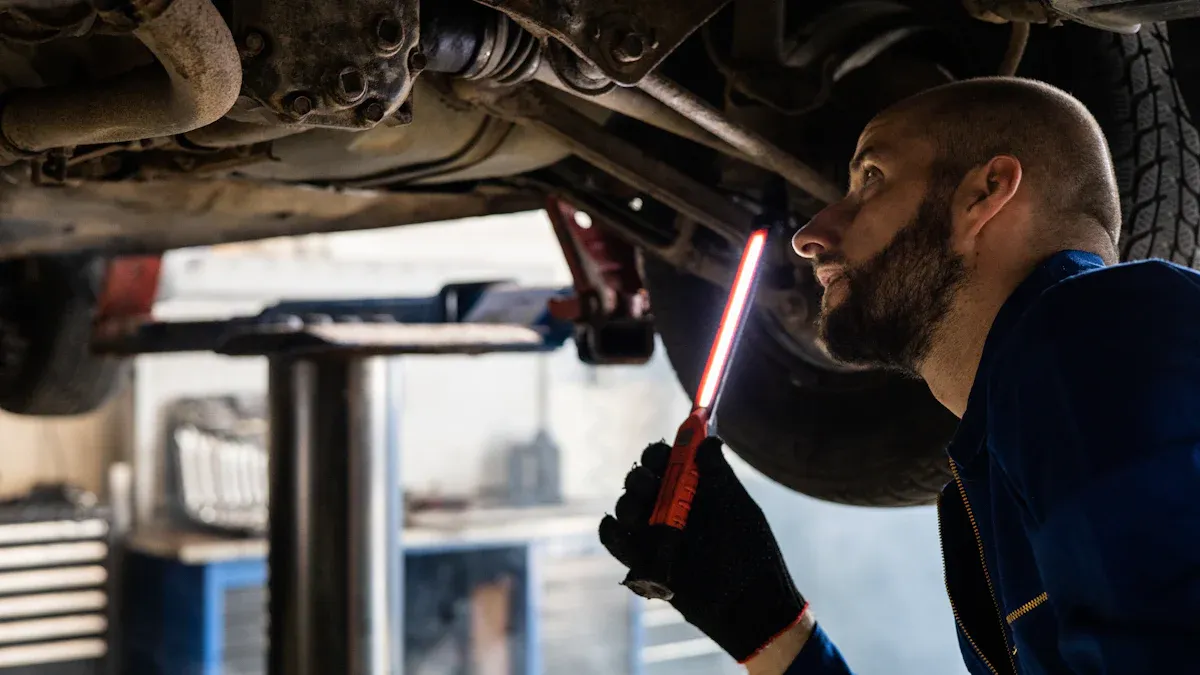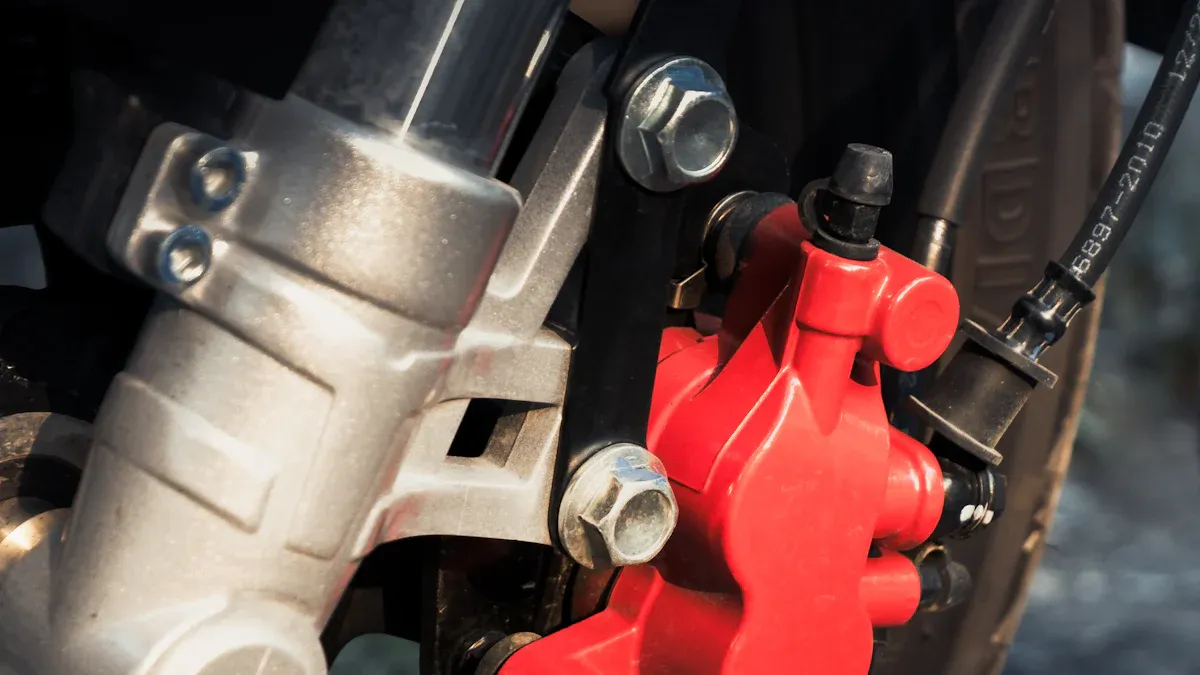
Your vehicle’s brake master cylinder plays a critical role in ensuring safe braking. When it malfunctions, you may notice warning signs that affect your car’s stopping ability. Ignoring these symptoms can lead to dangerous situations. Recognizing the early signs of a failing brake master cylinder helps you maintain control and avoid potential accidents.
Key Takeaways
- A soft or squishy brake pedal shows a problem. This can make stopping your car more difficult. Check your brakes if you notice this issue.
- If your brake pedal goes all the way down, it’s a big problem. This can make driving unsafe. Get it fixed right away.
- Check for brake fluid puddles under your car. Leaks can cause your brakes to stop working. Fix leaks fast to stay safe.
Key Symptoms of a Bad Brake Master Cylinder

Spongy or Soft Brake Pedal
A spongy or soft brake pedal is one of the first signs of a failing brake master cylinder. When you press the brake pedal, it should feel firm and responsive. If it feels soft or spongy, the brake system may not be building enough pressure. This issue often occurs when air enters the brake lines or when the master cylinder’s internal seals wear out. A soft pedal can make it harder to stop your vehicle safely.
Brake Pedal Sinks to the Floor
If your brake pedal sinks to the floor when you apply pressure, it’s a clear warning sign. This happens when the brake master cylinder fails to maintain hydraulic pressure. Internal leaks or damaged seals can cause this problem. Driving with this symptom is dangerous because it reduces your ability to stop the vehicle effectively.
Reduced Braking Power
A bad brake master cylinder can lead to reduced braking power. You may notice that your car takes longer to stop or doesn’t stop as quickly as it should. This symptom often results from a loss of hydraulic pressure in the braking system. Without proper pressure, the brakes cannot function at full capacity.
Brake Fluid Leaks
Brake fluid leaks are another common symptom. The brake master cylinder contains brake fluid, which is essential for creating hydraulic pressure. If you notice fluid pooling under your car or a drop in brake fluid levels, the master cylinder might be leaking. Addressing this issue quickly is crucial to prevent complete brake failure.
Warning Lights on the Dashboard
Modern vehicles often have dashboard warning lights that indicate brake system problems. If the brake warning light or ABS light turns on, it could point to a failing brake master cylinder. These lights alert you to potential issues that need immediate attention.
Vibrations or Pulsations While Braking
Vibrations or pulsations in the brake pedal can also signal a problem with the brake master cylinder. While this symptom can result from other issues, such as warped rotors, it’s worth investigating the master cylinder. Consistent vibrations during braking should never be ignored.
Why These Symptoms Occur
Internal Seal Failure
The brake master cylinder relies on internal seals to maintain hydraulic pressure. Over time, these seals can wear out or crack. When this happens, the cylinder cannot hold pressure effectively. You may notice symptoms like a sinking brake pedal or reduced braking power. Seal failure often occurs due to age or exposure to contaminated brake fluid. Replacing the seals or the entire cylinder is necessary to restore proper braking performance.
Air in the Brake Lines
Air in the brake lines disrupts the hydraulic system. Unlike brake fluid, air compresses under pressure, which reduces the force applied to the brakes. This can cause a spongy or soft brake pedal. Air can enter the system during repairs or if the brake fluid level drops too low. Bleeding the brake lines removes the air and restores normal braking.
Brake Fluid Contamination
Brake fluid contamination is another common cause of brake master cylinder issues. Dirt, moisture, or debris can enter the fluid, reducing its effectiveness. Contaminated fluid can corrode the cylinder and other components, leading to leaks or seal damage. Regularly replacing the brake fluid helps prevent this problem.
Wear and Tear Over Time
Like any mechanical part, the brake master cylinder wears out with use. Continuous pressure and exposure to heat can weaken its components. Over time, this wear leads to reduced performance and potential failure. Regular maintenance and inspections help you catch these issues early, ensuring your brakes remain reliable.
Steps to Take If You Notice Symptoms

Perform a Basic Brake System Check
Start by inspecting your vehicle’s brake system. Look for visible signs like brake fluid leaks under the car or near the master cylinder. Check the brake fluid level in the reservoir. If it’s low, refill it with the recommended fluid type. Press the brake pedal and observe its behavior. Does it feel spongy or sink to the floor? These checks help you identify potential issues quickly.
Tip: Use a flashlight to examine hard-to-see areas around the master cylinder. This can reveal leaks or damage that might otherwise go unnoticed.
Consult a Professional Mechanic
If you suspect a problem, contact a certified mechanic immediately. They have the tools and expertise to diagnose the issue accurately. Mechanics can perform advanced tests, such as checking hydraulic pressure or inspecting internal seals. They’ll recommend whether to repair or replace the master cylinder.
Note: Attempting complex repairs without proper knowledge can worsen the problem. Leave major fixes to professionals.
Avoid Driving Until Repairs Are Made
Driving with a faulty brake master cylinder puts you and others at risk. Reduced braking power can lead to accidents. Park your vehicle in a safe location and avoid using it until repairs are complete.
Post time: Apr-06-2025

